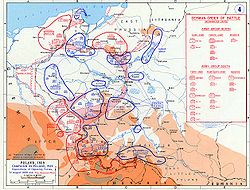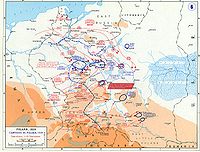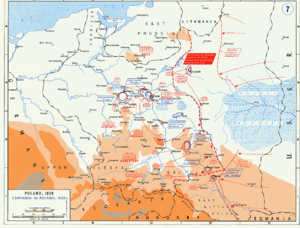
Modlin Army
Encyclopedia

Invasion of Poland (1939)
The Invasion of Poland, also known as the September Campaign or 1939 Defensive War in Poland and the Poland Campaign in Germany, was an invasion of Poland by Germany, the Soviet Union, and a small Slovak contingent that marked the start of World War II in Europe...
of 1939. After heavy casualties in the battle of Mława (September 1-3), the Army was forced to abandon its positions near Warsaw around September 10; eventually it took part in the battle of Tomaszów Mazowiecki
Battle of Tomaszów Mazowiecki
Battle of Tomaszów Mazowiecki refers to the battle on 6 September 1939 near the town of Tomaszów Mazowiecki, Second Polish Republic, during the Invasion of Poland....
(September 21-26) and surrendered afterwards.
Tasks
Named after the Fort Modlin (where its initial headquarters were located), it was officially created on March 23, 1939 with the task of defending Polish capital of WarsawWarsaw
Warsaw is the capital and largest city of Poland. It is located on the Vistula River, roughly from the Baltic Sea and from the Carpathian Mountains. Its population in 2010 was estimated at 1,716,855 residents with a greater metropolitan area of 2,631,902 residents, making Warsaw the 10th most...
and the city of Płock from the north. It took positions near the fortified lines along the border with East Prussia
East Prussia
East Prussia is the main part of the region of Prussia along the southeastern Baltic Coast from the 13th century to the end of World War II in May 1945. From 1772–1829 and 1878–1945, the Province of East Prussia was part of the German state of Prussia. The capital city was Königsberg.East Prussia...
near Mława, and was supposed to retreat in the organized fashion towards the second line of defense towards Narew
Narew
The Narew River , in western Belarus and north-eastern Poland, is a left tributary of the Vistula river...
and Vistula
Vistula
The Vistula is the longest and the most important river in Poland, at 1,047 km in length. The watershed area of the Vistula is , of which lies within Poland ....
rivers.
Operational history

Mazowiecka Cavalry Brigade
Mazowiecka Cavalry Brigade was a cavalry unit of the Polish Army in the interbellum period, which took part in the Polish September Campaign. It was created on April 1, 1937, out of former 1st Cavalry Brigade...
) have arrived in their designated areas only by 30 August (and its area had only 3 out of 40 planned fortifications completed).
During the battle of the border
Battle of the Border
The Battle of the Border refers to the battles that occurred in the first days of the Nazi Germany invasion of Poland in September, 1939...
(particularly the battle of Mława on September 1-3) the Army was pushed back by the German Third Army, towards Narew and Bug rivers. It received reinforcements in the form of the Operational Group Wyszków under general Wincenty Kowalski
Wincenty Kowalski
Wincenty Kowalski was a Polish military commander and a general of the Polish Army. A veteran of both the World War I and World War II, he fought in all the inter-war conflicts of Poland...
but they were not sufficient to stop it from having to fall back. Eventually around September 10 the Army abandoned its positions near Warsaw; some of the units (primarily the 20th Infantry Division) remained in the Warsaw area joining the Warszawa Army
Warszawa Army
The Warszawa Army was one of the Polish armies to take part in the Polish Defensive War of 1939. Created on 8 September, eight days after the invasion begun, it was an improvised formation charged with the defence of the Polish capital of Warsaw ....
taking part in the final defense of Warsaw
Siege of Warsaw (1939)
The 1939 Battle of Warsaw was fought between the Polish Warsaw Army garrisoned and entrenched in the capital of Poland and the German Army...
; others were pushed to the south east (Romanian Bridgehead
Romanian Bridgehead
The Romanian Bridgehead was an area in southeastern Poland, now located in Ukraine. During the Polish Defensive War of 1939 , on September 14 the Polish Commander in Chief Marshal of Poland Edward Rydz-Śmigły ordered all Polish troops fighting east of the Vistula to withdraw towards Lwów, and...
) and took part in the battle of Tomaszów Lubelski
Battle of Tomaszów Lubelski
Battle of Tomaszów Lubelski took place from 17 September to 26 September 1939 near the town of Tomaszów Lubelski. It was the second largest battle of the Invasion of Poland and also the largest tank battle of the campaign. It resulted in the destruction of the Polish forces...
(September 21-26) after which most of them were forced to surrender.
Organization

Emil Krukowicz-Przedrzymirski
Emil Krukowicz-Przedrzymirski also known as Emil Karol Przedrzymirski de Krukowicz was a Polish general.Krukowicz-Przedrzymirski was born in 1886. He began military service as an artillery officer in the Austro-Hungarian Army during World War I. He joined the Polish Army in 1918 and fought in the...
; his chief of staff was col. Stanisław Grodzki. It consisted of 2 infantry divisions and 2 cavalry brigades. On a lower level of organization it had 28 infantry battalions, 37 cavalry squadrons, 180 artillery pieces, 12 anti-air artillery pieces, 1 armored train (nr 13, former "Generał Sosnkowski") and 28 planes.
- 8th Infantry DivisionPolish 8th Infantry DivisionThe 8th Infantry Division was a tactical unit of the Polish Army. It was active in the Polish-Bolshevik War, as well as during the Invasion of Poland in 1939...
(8 Dywizja Piechoty) from Modlin - 20th Infantry Division (20 Dywizja Piechoty) from Baranowicze
- Nowogródzka Cavalry BrigadeNowogródzka Cavalry BrigadeNowogródzka Cavalry Brigade was a cavalry unit of the Polish Army in the interbellum period. It was created on April 1, 1937, out of the Baranowicze Cavalry Brigade. Its headquarters were stationed in the town of Baranowicze...
(Nowogródzka Brygada Kawalerii) - Mazowiecka Cavalry BrigadeMazowiecka Cavalry BrigadeMazowiecka Cavalry Brigade was a cavalry unit of the Polish Army in the interbellum period, which took part in the Polish September Campaign. It was created on April 1, 1937, out of former 1st Cavalry Brigade...
(Mazowiecka Brygada Kawalerii) - Warsaw National Defence Brigade (Warszawska Brygada Obrony Narodowej)
Aviation of the Modlin Army
- (Pluton łącznikowy nr 11)
- (41. Eskadra Rozpoznawcza)
- (III/5. Dywizjon Myśliwski)
- Polish 152nd Fighter EscadrillePolish 152nd Fighter EscadrilleThe 152. Fighter Escadrille was a unit of the Polish Air Force at the start of the second world war. In 1939 the unit was attached to the Modlin Army.-Air Crew:Commanding officer: kpt. pil...
(152. Eskadra Myśliwska)
- Polish 152nd Fighter Escadrille
- Polish 53rd Observation EscadrillePolish 53rd Observation EscadrilleThe 53rd Observation Escadrille was a unit of the Polish Air Force at the beginning of the Second World War. The unit was attached to the Modlin Army.-Equipment:7 RWD-14b Czapla airplanes and 2 RWD-8.source: Polish Wikipedia....
(53. Eskadra Obserwacyjna)
Further reading
- Tadeusz Jurga, Władysław Karbowski, Armia " Modlin" 1939, Wydawnictwo Ministerstwa Obrony Narodowej, 1987

